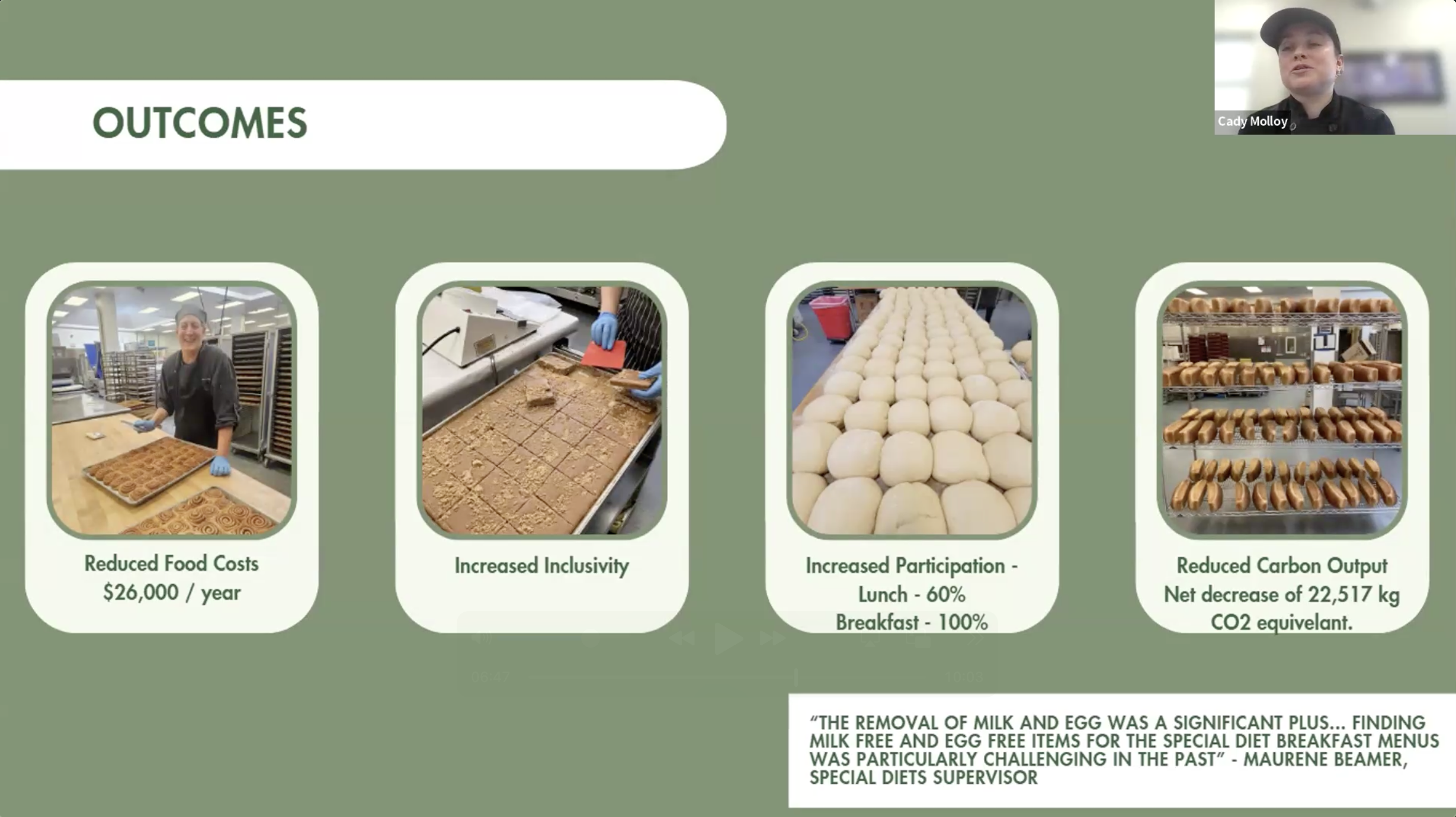3 strategies to crack the egg crisis—with help from subtle plant-based substitutions
The foodservice industry is no stranger to volatility, but the recent and ongoing egg crisis—marked by soaring prices and unpredictable availability—has resulted in particularly challenging supply chain conditions. From university dining halls to hospital kitchens and corporate cafeterias, the reliance on eggs as a staple ingredient has left many scrambling for solutions.
That’s why Greener by Default recently brought together three expert chefs to showcase the power of plant-based substitutions as a smart and sustainable strategy to navigate this crisis. Featuring insights from culinary leaders Chef Nina Curtis, Director and Executive Chef at Plant’ish & Co. Culinary Arts; Chef Cady Malloy, Executive Chef at Cherry Creek School District; and Rob Morasco, C.E.C., Vice President, Innovation at Sodexo Campus; the webinar provided practical takeaways for foodservice professionals looking to make their menus more resilient and cost-effective, without compromising on taste.
“Can we foolproof ourselves so that we’re not so challenged or thrown off our course when these things [like the egg crisis] happen?” asked Chef Nina Curtis, setting the stage for the conversation to come. “We have to have more than a backup, but a strategy…let’s focus on how we create solutions. We know what’s broken.”
From the lively discussion that followed, three key strategies emerged to help attendees harness the power of plant-based alternatives to navigate the egg crisis and futureproof their menus:
1. Embrace the versatility and seamlessness of plant-based swaps
Over and over again, our speakers emphasized the remarkable potential of subtle, plant-based substitutions to seamlessly replace eggs in multiple contexts, often without diners even noticing the difference. Having a number of versatile egg alternatives in your stable of ingredients is a powerful tool in the fight against market instability and price hikes–-while simultaneously aligning with growing consumer interest in sustainable and inclusive food options.
What makes egg alternatives so versatile? Chef Rob Morasco, who leads innovation across Sodexo's campus segment, explained that the possibilities for simple swaps are so extensive because they serve different roles in different meals and dishes: at breakfast time, eggs are often one of the stars of the show, but “they really serve a function in desserts, not necessarily a flavor component.” When the primary purpose of eggs is binding or leavening, a well-chosen plant-based alternative can perform the same task effectively without altering the desired flavor profile.
In classic desserts like cakes, muffins, and cookies, many plant-based recipes utilize ingredients like applesauce, mashed bananas, or even aquafaba (the liquid from canned chickpeas) to provide the necessary moisture and binding properties that eggs traditionally offer. The result? Delicious treats that are indistinguishable from their egg-containing counterparts, offering a "stealth" solution to reduce egg dependency. When Cherry Creek School District set out to replace eggs in one of their signature baked goods, Chef Cady Malloy and her team experimented with applesauce as a simple, easy-to-procure, cost-effective substitute—and it proved to be a near-immediate home run.
Steps that Cherry Creek School District took to transition their bakery away from conventional eggs, shared by Executive Chef Cady Malloy.
Plant-based alternatives can equally shine in breakfast applications: While scrambled eggs might seem irreplaceable on the plate, the webinar highlighted creative and appealing options like made-to-order pancake bars with diverse toppings or savory hash brown bowls with roasted vegetables and flavorful sauces. These alternatives not only sidestep egg-related challenges, but also offer exciting and customizable experiences that can be even more enticing to diners—making them feel like, as Chef Morasco suggested, they get to enjoy a "pop-up treat” that’s unique and different from standard breakfast fare.
The bottom line from both chefs was clear: subtle plant-based substitutions for conventional eggs are not only numerous, but easy to implement. By focusing on creating delicious and appealing dishes where the absence of eggs is not a compromise, foodservice operators can navigate the egg crisis without alienating their customer base or sacrificing quality.
2. Win hearts and minds by prioritizing diner experiences
While ensuring plant-based egg substitutes can be implemented seamlessly is key, foodservice operators can’t lose sight of the importance of a guest-centric approach. Integrating alternatives successfully hinges not just on the quality of the food itself, but also on how it is presented and communicated to diners looking to try exciting new options and enjoy their long-time favorite dishes.
Chef Morasco passionately emphasized the need to make plant-based options equitable, relatable, approachable, and, most importantly, craveable. He cautioned against leaning into the boring, unindulgent stereotypes often associated with vegetarian or vegan food: "When we walk into a dining facility and we say, hey, your plant-based stuff is over there in the corner, the sad brown stew with rice. Come on, folks, we can do better."
Benefits of offering crave-worthy plant-based dishes to make menus more equitable and enticing for Gen Z diners, shared by Chef Rob Morasco.
To truly win over diners, plant-based alternatives need to be visually appealing, smell enticing, and be described using language that highlights their delicious flavors and ingredients, rather than focusing on what might be missing. Strategic communication is paramount: instead of highlighting the absence of eggs, emphasize the delicious ingredients and flavors. For example, instead of "Egg-Free Chocolate Cake," consider "Rich Chocolate Cake with a Decadent Fudge Frosting." During the webinar, Chef Morasco shared a long list of examples of vibrant and flavorful plant-based dishes that Sodexo has introduced on campuses, underscoring that:
"If they find it appealing—it looks great, it smells great, the description's good—they're probably gonna try it."
He also stressed the importance of engaging with customers and seeking their feedback. "Talk to the students,” he said. “I talk to them about what they like, what they don't like. It's very interesting...You can tell me something sucks, but you have got to tell me why." This direct interaction provides invaluable insights, demonstrates commitment to diner satisfaction, and allows foodservice operators to refine their offerings based on customer preferences.
Ultimately, successfully navigating the egg crisis with plant-based substitutions requires commitment to a mindset that prioritizes creating delicious food that appeals to everyone, regardless of their dietary preferences, and communicating its appeal effectively. By prioritizing the guest experience and focusing on flavor, presentation, and enticing labeling, foodservice operators can turn a challenge into an opportunity to innovate and delight their diners.
3. Don’t miss out on the benefits for sustainability, inclusivity, and your bottom line
Throughout the webinar, our panelists also shared that, beyond simply offering techniques for mitigating the effects of the egg crisis, there is also a compelling array of additional, evergreen benefits that plant-based substitutions can offer for foodservice operators in every sector—including significant cost savings, increased inclusivity for diners with allergies and other dietary restrictions, and a reduced environmental footprint.
Chef Malloy provided a powerful real-world example of these benefits in action: Faced with the high prevalence of milk and egg allergies among the 53,000 students in Cherry Creek School District, her team embarked on a mission to remove these allergens from their central bakery's quick bread recipes. The recipes came together quickly and easily, and were a huge hit with students—but what surprised them even more were the unintended benefits that came to light.
Chief among them was the staggering cost savings. "We have reduced our food costs by about $26,000 a year,” Chef Malloy said. “$26,000—that's insane, right? Especially because for us, that was not actually our driving reason for doing this." This substantial reduction in food costs, achieved simply by substituting eggs with applesauce and adjusting the ratio of baking powder accordingly, demonstrates the significant economic advantages of embracing plant-based alternatives, especially in large-scale operations with razor-thin budgets.
Outcomes of Cherry Creek School District’s transition to plant-based baked goods, shared by Executive Chef Cady Malloy.
Beyond the financial benefits, the move towards egg-free and dairy-free baking dramatically increased inclusivity for students with allergies. Chef Malloy explained: "We have hundreds of kids that are now able to eat our scratch-made, low sugar, whole wheat products from our bakery,” she said. “Previously, if you had an egg or dairy allergy, we would still give you a breakfast, but it would be a higher processed, higher sugar, wrapped product." By offering delicious and nutritious baked goods that cater to a wider range of dietary needs, the school district enhanced the dining experience for all students, fostering a more equitable food environment.
Furthermore, Chef Malloy highlighted the positive environmental impact of their plant-based transition, which reduced Cherry Creek’s carbon output by approximately 22,000 kilograms of CO2. By reducing their reliance on animal products like eggs, the school district significantly lowered its carbon footprint, building resilience into their supply chain and contributing to a more sustainable food system.
“I care about these kids so much,” Chef Malloy said. “I want to make sure they’re not hungry and they’re healthy every single day, but I also want to make sure they have a planet to live on when they’re my age or older.”
Cherry Creek’s success story serves as a compelling testament to the multifaceted benefits of embracing plant-based substitutions. By viewing the egg crisis not just as a challenge but as an opportunity to innovate, foodservice operators can unlock significant cost savings, create more inclusive dining environments, and contribute to a more sustainable future.
“This was really easy…the positive outcomes were tenfold than what our original intentions were. As much as I’d like to share a story of resilience and overcoming obstacles, this was not a challenge. I think anyone could do this.”
Chef Cady Malloy
Greener by Default empowers institutions with evidence-based consulting and hands-on guidance to serve inclusive and delicious plant-forward menus that move the needle on health and sustainability, while protecting freedom of choice. GBD works primarily with hospitals and healthcare institutions, colleges and universities, corporate cafeterias, and large catered events, using behavioral science to nudge diners towards more sustainable, healthy, plant-based options by making them appealing, abundant, and accessible.
Interested in working with GBD? Start the conversation.




